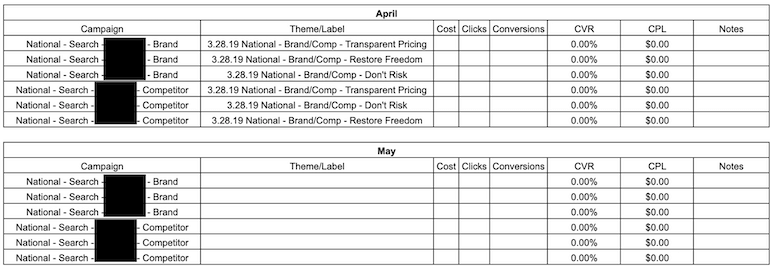I go back and forth on whether ad copy truly makes an impact on PPC. I’ve heard stories of how my co-worker’s sister literally just clicks on the first result on the SERP page or how one time this guy was working on an account and saw that there were still Black Friday ads running in May and they were straight up killin’ it. I’ve also worked with clients and poured over copy to get the message and branding just right. Creative is something I definitely care about, but it’s such a fickle cat. I’m tasked with trying to craft the message that will equally speak to my co-worker’s click-happy sister, the inevitable grammar-nazi that actually reads what they’re looking at on the internet, and the person who skims but doesn’t dive into the text (there are obviously a lot more types of people on the internet, but these are the people who come to mind).
A creative matrix is an easy way to organize how you want to approach ad copy and keep you accountable to your plan. One pitfall I’ve fallen into is throwing too many variations of ad copy at a problem campaign or ad group and finding that it just makes everything more complicated. Good ad copy variation isn’t about changing up one or two words or using “the” instead of “a”. Theme variation is where I’m learning the most about my audiences. For example, having an ad that speaks to pricing vs. an ad that speaks to expertise and an ad that highlights brand values. These messages help me learn what my audience really cares about.
Below is an example of a simple creative matrix. In April, I’ve launched new ad copy that is labeled with the “Theme Label” I’ve created in the Theme/Label column.

At the end of the month, I’ll pull the data and compare how each theme performed in the Brand against the Competitor campaign. From there, we’ll be able to determine which themes to continue running in May along with what theme we want to pivot to test to replace the losers.
Pop in whatever metrics match your KPIs and experiment with the layout to fit your needs. Since we’re aggregating data off of an implemented label, you can also easily create a pivot table that illustrates your data.
Final Thoughts
Organization is crazy important for campaign management. It can be really easy to want to test or run toward anything that sounds interesting or profitable, but without a strategy in place, it will likely end up a bust. Taking time out to properly map out your ideas can help you be more prepared for what’s to come.



